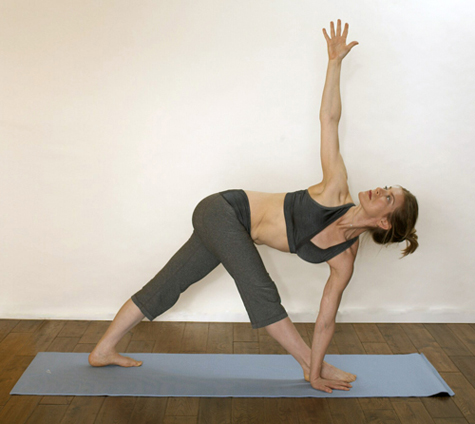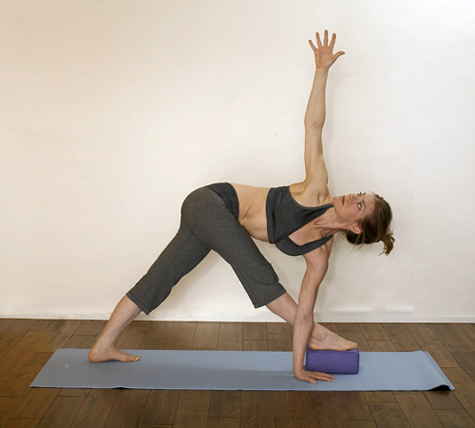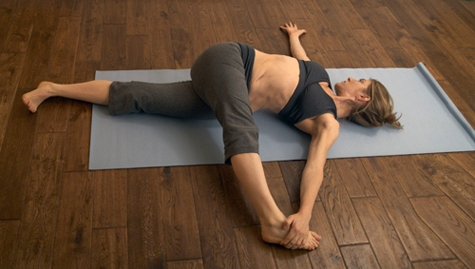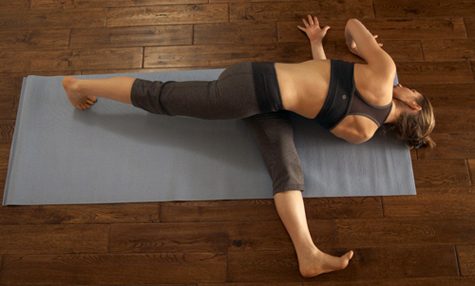
[See the first half of this article here.]
Snow globe yoga: Shake it up! Inspiration comes in many forms. One of my favorite ways of practicing is to pick a pose, any yoga pose, and then imagine that pose in a snow globe. I shake up the imaginary snow globe and let the pose land in any and every possible orientation. The pose may land on its side, its back, its front, on one foot, etc. Maybe I throw a few props into this imaginary world, too. Then I practice the yoga pose variations.
You will learn so much about the components of your pose by changing its relationship to gravity. It is endlessly amusing and produces dozens of variations … many of which are even more effective for your body than the “classical” version! This satisfies the body’s and mind’s need for novelty, and will also teach you about the relationship between the muscles and tissues surrounding your joints in a given pose. Often we are unaware of how to use the many structures that are required to build integrity in a pose. When you “shake up” a pose, you shake up your practice, and your “yoga block” becomes a helpful prop rather than a hindrance in your evolving practice!
So pick a pose and get started! Here’s a series I recently did with Triangle Pose:




Staying fresh and excited about yoga ultimately boils down to being willing to see your practice — and your poses — as variable and interesting and as exquisite as real snowflakes: Even though they may all appear the same, look closer and you will see each one’s uniqueness.
Need more inspiration? Come practice with me at any one of my upcoming workshops or trainings to help step out of your yoga rut!
Read about the most important part of a yoga pose.
Learn about Yoga Tune Up at home.
Find a Yoga Tune Up class or workshop near you.
[Reprinted with permission from GaiamLife.]












Coming from the perspective we are energy bodies and energy moves through us from the earth and the universe. Shaking the globe or changing the orientation of a posture so the angels, compressions, extensions etc are also altered is BRILLIANT! I like how this concept gives us freedom to explore classic poses flips them around to adjust how the energy is mapping through the being because we are continually changing. THANK YOU
The snow globe yoga is one of he most interesting, eye opening and most fun I have had in a long time doing yoga poses. It made some of the most boring poses all of a sudden the most fun. Using your imagination and using a wall, a prop or your partner in yoga to try out new sides of your body yet maintaining a similar shape is for sure helping you find the right positioning of your hip, shoulder and spine. And I just keep finding new ways to land when I shake the globe. Thank you!!
It’s very interesting how the same posture can work different muscles just changing the orientation. A lot of creativity and changing perception.
Super helpful blog following YTU training; for the “non-yoga teacher” this was a fun read to get excited about the challenges to come. Since leaving YTU teacher training, I have had fun incorporating the different poses into my physio practice and learning the importance and the skills of changing pose orientation with clients who aren’t as flexible, who have mobility limitations, or do not want to go on the ground. What a learning curve!
Great info. It’s so much fun to be creative and curious with the poses and learn how a new way feels in your body. I love being able to have the freedom to try poses in a new way and my class loves it too!
Most practical and right away applicable tool! as the most important one can say to think in more than one dimension.
This post produced a light bulb moment for me. I’ve been struggling too hard and getting in my own way as I think about changing up a pose letting principles of gravity guide me.
Turn the world upside down or sideways. Play with the yoga poses, it does make life more interesting instead of the same old, same old. Great blog!
Jill, Your are dynamite!
(How’s that for punny?)
Thanks for helping us keep it fresh.
Another great take-away I got in this weeks training: the sofa analogy: do not sit always in the same spot…. the sofa will wear out quickly. Try another spot and the sofa will be functional another 20 years. Change the orientation of the pose.
I love the unending creativity I get to play with. As a yoga teacher with a wild spirit and and this great information I can hold intellegent and fun classes. Yes!
This is probably the biggest takeaway I personally get from any one YTU training I have ever done! Shake it up! Then things get interesting. If I have limitations with a pose *cough* tight hamstrings *cough* I try a different variation and see what muscles need to work in a different relationship to help my hamstrings get the message that it is okay to let other areas do the work!
I love this idea, I find that not only does it add some excitement to my yoga practice but helps me to gain new perspective on old poses. Amazing
Understanding the pose’s relationship with gravity and being able to change it gives you an amazing tool for modifications for students. You really stand out as a teacher if you can find the best option for each students specific bodies and needs. Often the original pose can be improved by changing orientation, closing the chain or adding props.
This article was a treat! My career (advertising) is based off of thinking outside the box. But i often forget to apply this thought to other aspects of my life. Yoga has always been so precise, but trying these postures in a new manner might be the perfect solution to dig deeper!
Such a great way, not only to continue to challenge me as a teacher and keep it fresh, but continue to educate the students who happen to come to my class. I love the look of the “aha” on their faces when I after a peak pose of Warrior 3, that I tell them that they were already “doing” the pose since the beginning of class…and then I list the component parts or muscles in various poses that brought them to the peak or some form of the peak pose based on their body. It really takes the “oh I can’t do this pose or that pose” out of their way of thinking, because there is a place for them!
Thanks for the inspiration Jill! I tried it today in the first day of YTU TT — the forward fold with one foot up on a block. Amazing how different it feels and all the strong sensations that can arise from that little change. I also have tried downward dog on blocks before and it really gives you that extra length in the upper body — btw – that was the first time I was finally able to get my heels down during downward dog! 🙂 Love!
LOVE IT! What a great idea for so many reasons: 1. It’s not boring! 2. You are experiencing your body differently in the same poses. 3. What a great class sequencing idea! I love this and think it’s the perfect thing to suggest to a student of all ages – and also something fun to do on your own!
This is so helpful and really allows you to think outside the box in a pose. During the anatomy portion of my teacher training Sarah had us do this with Adho Mukha Svanasana. It was so freeing to practice the posture in different variations and allowed you to focus on alignment inside the “snowglobe”.
Although Triangle and Twisted Triangle are my most dreaded poses, props, orientation and support make them a little less daunting. Having very long legs and relatively short arms, for me yoga wouldn’t be possible without props. The understanding I get by being in the pose – turned upside down and on it’s ear to change the orientation – helps me feel confident enough to attempt it in it’s organic orientation… most of the time.
I love shaking up practice with the snow globe – and watching light bulbs go off all over the room as students begin to make connections between the poses! Thanks, Jill!
I love these variations. I can’t wait to try them in my practice. Twisted Triangle with block under foot is genius! As well as the threaded arm version when lying down.
I have tended to sequence with a variation of this in mind, highlighting the actions of the component parts of poses or the pose itself in different relationships to gravity. (“Notice how this is the same action we did on the floor and see if you can find that action here”). But you got me to think so much deeper about it. For instance, I’ve taught Warrior 2 in various ways against the wall, to teach a particular action of the pose, like maybe the pressing of the outer edge of the back foot, but I never considered it in terms of open and closed chains and the changes in the specific muscles involved, which is fascinating to me and inspires me to get more creative and play around with other poses in that way. I can’t wait to bring this into my classes. 🙂
I just did reorientation of the Uttanasana and it is interesting how there can be subtle or intense differences in muscle use during each orientation. For example, sitting with legs and arms up in a closed chain my infraspinatus and posterior deltoid were much more engaged. Also, when using open and closed chains I can instantly feel activation or deactivation of a muscle (intended or not). Therefore, I need to make sure I properly do the pose without losing its integrity. It’s easy to get lazy on a closed chain! Thanks for the tip!
Changing the orientation of the pose really helps to feel each posture differently and it is greate way to perfect and deepen our practice. My yoga teacher often changed posters to make them more deeper. It was very refresing and I really enjoyd her classes. To having a block under the foot and make trikonasa on the floor is something I never tried before… I can¨t wait to try it..Thank you for this!
I like the idea of using creativity in yoga practice, trying to do a pose in many different ways and daring to experience different perspectives in the same asana…It is like to be open for different possibilities not only on the mat but also in daily life.
I really appreciated doing this very thing when Sarah Court conducted our anatomy training. It is interesting to think deeper about each pose and though it is practiced in different ways, the frequency or energy of the pose remains the same.
This is great fun! I have used this idea for a while in my practice, but I never called it Snow Globe! Great name for a great way to be connected to a pose in so many different ways. Thanks!!
Hm. Shaking it up. I am tempted, and inspired to try twisted triangle upside down, on my head! But I won’t, only kidding. (Parivritta Trikonasana Sirsasana?) – Seriously, I love the idea of tweaking these poses so as to gain clarity around what/which muscles are working. It must also shed light on alignment, and gravity for that matter. I’m seeing Vasistashina, Tadasana, and Shavasana as similar poses in variation!
Love this. I often forget how much gravity and/or props can change a pose completely. As a pretty hyper mobile person it is really benefical for me to approach a pose from a different angle to strengthen a pose rather than “dump” into it, I tried Parsvokonasana – with the front-bent leg up on a wall. it really allowed me to focus on rotating my spine open. Love creativity this allows for as well.
This is one of my favorite things about Yoga Tune Up. We can take a pose and just by changing the orientation in space it can be easier, harder, more accesible, and so informative. I love creatiing classes around the idea of doing a pose in as may ways as possible. I don’t call it snow globe yoga though, I call it Tetris.
I work with the disabled and when you had us do this exercise during our teacher training; it made me appreciate once again that even with yoga postures we can adapt, practice and teach them from various perspectives. Trying postures standing,sitting,against a wall, on the floor was a fun creative experience for my mind. It helps to develop a creative “eye”. Thanks for reminding me to practice with an open mind!
I love those moments when I realize that one pose is really just another familiar pose flipped on its head. I really enjoyed this post because it challenges us as future teachers to find new and different ways to come in and out of poses. We continue to develop our physical and mental selves by introducing novel approaches to our yoga practice.
This article made me want to jump right on my yoga mat and start the ‘snow globe’ idea!! What a great concept!
Love the idea of bringing Trikonasana to the floor! Can’t wait to try this.
Love the Snow globe concept! Great idea just focusing on one standard pose and adding variations to get different effects. I will be trying this in my own practice and may do this with my students as well. Very playful!
Love this! Any postures that step outside the box are wonderful! Adding something new to my practice is always refreshing. Exploring and staying in tune with my personal practice helps me to stay fresh and open the door for my students to explore new ways to keep their practice stong and fun as well! Thanks!
This idea has also allowed me to see traditional poses as simply a shift in orientation. For example Ustrasana, Dhanurasana, Setu Bhanda are all the same pose with a different orientation. I recently “saw” what my teacher calls Kailashasana (Hanumanasana holding the back foot with one hand and the the front foot with the other) in Natarajasana tipped forward and a variation of Ustrasana called Prati Padasana where one leg is raised right “in front of your eyes (prati)” while holding onto the back ankle. Crazy fun. Thanks for the new eyes.
I love this analogy because it shines light on the concept that learning basic technique will lead to success when building up to complex postures. I think going back to the basics is key in order to expand and deepen your practice. I have a new outlook and respect for props now after testing them out in class. Before realizing the importance of props I thought they were just for individuals who needed extra assistance… kind of like a crutch! I have been able to fine tune my yoga practice by using props to help me lengthen out through my lumbar spine and internally rotate my hips to a neutral position. I am looking forward to taking a deeper look into certain postures to help me retain correct technique that might have been lost along the way!!
I love this concept. Today I tried it with downward dog, and through each variation a different sensation could be felt. It is an amazing tool to deepen the study and understanding of different asanas. Not only does it help you feel each posture differently, but it is fun to come up with new ways to play with the shapes.
I love, love, love this. Changing the orientation of the pose (or adding a prop unexpectedly) is such a great tool to keep students interested. I love it when they say, “This feels SO familiar…”. I ask questions, they answer and then they have the a-ha! moment and realize what pose they’re in. Proprioception, knowledge and fun all wrapped up in one.
Your insight on the shake up really helped me see how gravity affects my asana in different ways. I am going to do the run over by a truck to some other poses!!! Thanks.
This was a great eye opener because sometimes when you’re in a pose you don’t even realize its the same pose sitting down as it is standing up. For instance, Janu Sirsasana when I’m sitting down is a lot easier for me than doing it standing up on one leg. Thanks Jill!
I completely agree with Holly! It’s really interesting to see how taking an open chained posture and closing it can really change the feeling in the muscles. I’ve also always thought of the yoga block as more of an aid for those who cannot “reach” a certain point, but now I’ve come to the realization that yoga blocks are designed to not only help a yoga student achieve their best form, but allows us to be more creative!
I love how changes, whether large or small, to a posture can completely change your experience in a pose. I find it challenging yet interesting to change a posture by changing the chain completely, for instance by taking a closed chain posture and making it open chain to complete change where I feel the posture. Or by changing how gravity impacts the posture. Another incredible change to make is to your breathing, perhaps using more abdominal breathing in a posture you’ve consistently used thoracic breathing in… perhaps it involves taking the pose to the ground rather than standing in order to be able to change your breathing in that manner. I think one of my favorite recent ‘snowglobe’ effects was feeling the difference in pigeon on my mat versus standing pigeon using a wall to assist me.
My yoga teacher did a two day practice with the focus just twisted triangle. Closed chain, open chain, supported, unsupported. Almost everyway you could think of to turn triangle pose around. I founed that my body was very happy with this experience and wanted a longer savasana. Thanks to my Yoga Tune balls my lower back felt as good as my hamstrings.
I’m very interested in learning how to do familiar poses with new approaches to them. For example, in my teaching program we are to come up with two ways to use the tune up balls in an area of our body (ie lower back) to discover how/if the pose feels differently on the particular muscles, joints or ligaments.
Thanks for this! I am one of those people that always does their poses in the same manner every time. Just by adding a block to my half moon and triangle poses last night, gave me a whole new experience.
This sounds like a fun exercise. Reminds me of how “Camel” feels like “Bow” but at a different angle and so gravity is in the opposite direction.
i love that you’re talking about this. i was trying to get creative the other day and thought, “why not twist pigeon?” so i threaded my arm underneath and was able to lay my upper torso flat on the mat. it’s always great to stay fresh in an old pose!
Bridge pose supported by the block was a great release for my lower back which is always so tight. I felt so relaxed in the pose I almost when to sleep. Thanks
Thank You jill for the idea of block support. My experince of bridge pose supporting my back with the block was a great back release. More block fun!
One of my yoga teachers taught a whole 90min class using the block in almost every asanas. What a treat to see the YTU program offer a block-fest. Boy that Supta Padangusthasana with a block is no joke! My psoas, it band and gluteus are saying yeah! Are there any tips on how to support the pose in a different way? Thanks.
The Neck stretch program was so great! My neck is always so tight, I don”t know if it’s how I sleep, but when I wake up my neck is so tight. The YTU tips and hands on self healing message was so great. I may have to buy new pillows. Are there any other great yogic neck asanas? Thanks
Yoga Block! I think using the block is so great. It helps to see all the fun things YTU does with the blocks. The information helps to extends my yoga practice in a new way. I love the effect and the feel of exploring new ways of using the yoga block. I”m still finding ways to open more door within my yoga experience. Great YTU
Loved “Stuck in a Rut? Shake it up”! This was so much fun and I can”t wait to try it. This whole concept takes my brain for a big fun loop. Thank you Jill!